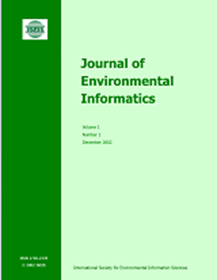基于自学习离散回归的地理空间信息扩散
IF 5.4
1区 环境科学与生态学
Q1 ENVIRONMENTAL SCIENCES
引用次数: 0
摘要
在研究地球表面的一种现象时,例如自然灾害、水污染和土地利用,某些地理单元的数据可能不足。大多数插值模型无法估计缺失的数据,因为它们依赖于连续的假设,然而大多数地理空间数据不是连续的。在本文中,我们开发了一种称为自学习离散回归(SLDR)的信息扩散技术来推断间隙单元的缺失数据。为了说明如何使用建议的模型,研究了一个基于中国洪水经验的虚拟案例,其中缺口单元的洪水损失与背景数据推断:人口、人均GDP和单元相对暴露于洪水。对比表明,SLDR算法明显优于地理加权回归算法(GWR)和反向传播神经网络(BP),分别减少了60%和33%左右的误差。为了证实特殊情况下的论点,用纯随机种子数进行了10次模拟实验。统计平均结果表明,GWR网络填充间隙单元的有效性值得怀疑,SLDR网络比BP网络更准确。本文章由计算机程序翻译,如有差异,请以英文原文为准。
Geospatial Information Diffusion Based on Self-Learning Discrete Regression
When studying a phenomenon on the earth surface, such as natural disaster, water pollution and land use, the data in some geographic units may be insufficient. Most interpolation models cannot estimate missing data because they rely on continuous assumptions, however most geospatial data is not continuous. In this article, we develop an information diffusion technique, called self-learning discrete regression (SLDR), to infer the missing data of the gap units. To show how to use the suggested model, a virtual case based on flood experience in China is studied, where flood losses of the gap units are inferred with background data: population, per-capita GDP and relative exposure of the unit to flood. To the case, a comparison shows that SLDR is obviously superior to geographically weighted regression (GWR) and the back propagation neural network (BP network), reducing the error about 60% and 33%, respectively. To substantiate the special case arguments, ten simulation experiments are done with pure random seed numbers. The statistical average results show that the validity of GWR for filling gap units is doubtful, and SLDR is more accurate than BP network.
求助全文
通过发布文献求助,成功后即可免费获取论文全文。
去求助
来源期刊

Journal of Environmental Informatics
ENVIRONMENTAL SCIENCES-
CiteScore
12.40
自引率
2.90%
发文量
7
审稿时长
24 months
期刊介绍:
Journal of Environmental Informatics (JEI) is an international, peer-reviewed, and interdisciplinary publication designed to foster research innovation and discovery on basic science and information technology for addressing various environmental problems. The journal aims to motivate and enhance the integration of science and technology to help develop sustainable solutions that are consensus-oriented, risk-informed, scientifically-based and cost-effective. JEI serves researchers, educators and practitioners who are interested in theoretical and/or applied aspects of environmental science, regardless of disciplinary boundaries. The topics addressed by the journal include:
- Planning of energy, environmental and ecological management systems
- Simulation, optimization and Environmental decision support
- Environmental geomatics - GIS, RS and other spatial information technologies
- Informatics for environmental chemistry and biochemistry
- Environmental applications of functional materials
- Environmental phenomena at atomic, molecular and macromolecular scales
- Modeling of chemical, biological and environmental processes
- Modeling of biotechnological systems for enhanced pollution mitigation
- Computer graphics and visualization for environmental decision support
- Artificial intelligence and expert systems for environmental applications
- Environmental statistics and risk analysis
- Climate modeling, downscaling, impact assessment, and adaptation planning
- Other areas of environmental systems science and information technology.
 求助内容:
求助内容: 应助结果提醒方式:
应助结果提醒方式:


